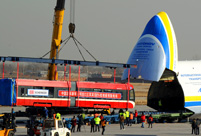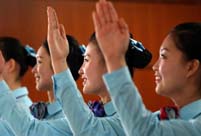BEIJING, Dec. 6 -- They say that to know the future, you should look at the past. If this is the case, then the many years of cooperation between the People’s Republic of China and the Food and Agriculture Organization of the United Nations (FAO) in the fight against hunger are an encouraging sign of things to come.
In 2013, the People’s Republic of China and the FAO celebrate 40 years of a fruitful collaboration. This partnership has contributed to improving food security in China and in the world.
China placed a priority on improving world food security early on, as one of the nations that committed to forming FAO in 1945. After resuming membership of FAO in 1973, China went on to register some of the world’s sharpest declines in poverty and chronic hunger. It has already satisfied the hunger-reduction target specified in UN Millennium Development Goal number one, namely, to halve the proportion of chronically hungry people between 1990 and 2015.
In addition, the absolute number of people experiencing chronic hunger in China has declined by at least 42 percent since 1990, from 272.1 million in 1990-92 to 158 million in the 2011-2013.
These achievements by a country with 20 percent of the world’s population translate into a significant step forward in the fight against global hunger. The 114 million people that China has rescued from hunger since 1990 represents nearly two-thirds of the total 173 million people lifted from food insecurity worldwide.
FAO has been part of China’s efforts. FAO has assisted China develop nearly fifty investment projects for total investments of over 8.3 billion dollars and has provided technical support to over 400 field projects benefiting tens of millions of people across the country. Specific projects have increased the availability of improved services and tools like water, roads, and agricultural technologies.
Through a Global Environmental Facility (GEF) project, FAO and China work on the conservation of traditional ecosystems and methods through the Globally Important Agricultural Heritage Systems (GIAHS). It has helped local communities to protect managed areas like the country’s rice-fish-duck farming systems, and it has used GIAHS-related product labeling, or branding, to promote confidence in local agricultural products and improve the income of rural communities.
FAO and China have also worked together to support creation of successful animal-disease surveillance activities. FAO’s Emergency Center for Transboundary Animal Diseases (ECTAD), for example, has worked with the Chinese government over the years to expand the capacities of national and provincial partners to deal with various emergency animal-disease situations, including the massive international outbreak of H5N1 Highly Pathogenic Avian Influenza in 2004.
FAO is committed to continue working together with China. After all, there is, still, much work to be done to promote food security and reduce rural poverty; advance the sustainable management of natural resources; improve food safety testing and risk assessment; develop and disseminate agricultural technologies; and enhance capabilities that are needed in a globalized agriculture and trade context, such as policies and statistics gathering.
The will and the roadmap are there with a strategic plan for deepening the agricultural and rural reform indicated in the recently issued Communiqué of the Third Plenary Session of the 18th Central Committee of the Communist Party of China. I am confident that, under this new leadership, China will achieve even greater success in its rural development and will thus give an even greater contribution to world food security.
As it continues to work on hunger, malnutrition and poverty at home, China is, increasingly, using its technical expertise to support food security and agriculture-related initiatives in 24 other countries in Africa, Asia, the Caribbean and the South Pacific, through South-South Cooperation initiatives implemented with FAO.
This is important because the war against hunger is far from over. Worldwide, an estimated 842 million people still live with chronic hunger, while another 2 billion suffer serious nutrition-related problems.
Since 1996, nearly 1,000 Chinese experts have provided support in many regions of the world in irrigation, livestock, fisheries, crop production, agroforestry and other areas. They have included sharing improved technologies in rice production, irrigation and aquaculture in Nigeria; introducing 200 improved crop varieties in Malawi; and, improving crop and livestock production under extreme climatic conditions in Mongolia. This effort was strengthened in 2008, when China created a $30 million trust fund in support of South-South Cooperation through FAO.
China will be able to multiply the benefits of its successes by continuing to share its knowledge, technical expertise and funding with developing countries worldwide. A new proposal for a five-year, FAO-China cooperation program has been developed with a view to scaling-up the impact of South-South Cooperation on food security and nutrition, including support for quality-assured production of veterinary vaccines for Africa; strengthening and networking agricultural research and training centers; development of aquaculture; renewable energy development; and, the protection of agro-ecosystems.
These plans would set an inspiring example for other countries to increase their own participation in South-South cooperation.
Eliminating chronic hunger is an enormous challenge that most countries share, but there is no one-size-fits-all solution. Each country is unique and must make decisions about the best ways to ensure domestic food security and self-sufficiency in the face of economic, social and natural resource-related challenges. But by continuing to share its insights and expertise, China can help others to develop workable, locally adapted strategies that contribute to a sustainable and hunger-free future.
*The author is the Director-General of the UN Food and Agriculture Organization.
 Heavy cargo flights taking off
Heavy cargo flights taking off In pictures: PLA's digital equipment
In pictures: PLA's digital equipment  Americans mark Thanksgiving Day with parades
Americans mark Thanksgiving Day with parades Self-made farmer billionaire donates 69 villas at hometown
Self-made farmer billionaire donates 69 villas at hometown Demolition of bizarre rooftop villa in Beijing still in progress
Demolition of bizarre rooftop villa in Beijing still in progress Service seminar for E China train attendants
Service seminar for E China train attendants  China's first nude photographer
China's first nude photographer Selected sports photos of the week
Selected sports photos of the week Treasure of Chinese culture- Nuo Dance
Treasure of Chinese culture- Nuo Dance  Youths in Night club: photo story
Youths in Night club: photo story Models dazzle at Int'l Yacht Model Pageant
Models dazzle at Int'l Yacht Model Pageant  Crystal scenery in China: Jilin fog glaze
Crystal scenery in China: Jilin fog glaze  Tianjin holds first pole dance championship
Tianjin holds first pole dance championship  Annual Santa Claus parade held in Canada's Montreal
Annual Santa Claus parade held in Canada's Montreal China's aircraft carrier passes through Taiwan Strait
China's aircraft carrier passes through Taiwan StraitDay|Week|Month